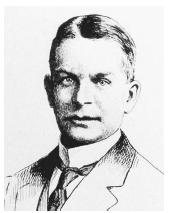Frederick Soddy
ENGLISH RADIOCHEMIST
1877–1956
Frederick Soddy, the youngest of seven sons of a London corn merchant, was born on September 2, 1877, in Eastbourne, England. Raised by his half-sister, this precocious scientist attended Eastbourne College (1892–1894) and the University College of Wales, Aberystwyth (1895). In 1895 he won a scholarship to Merton College, Oxford University, from which he graduated with the highest honors in chemistry (1898).
After two years of research at Oxford, Soddy served as a demonstrator (laboratory instructor) at McGill University in Montreal, Canada (1900–1902), where he worked with Ernest Rutherford, studying the gaseous emanation of radium and showing that radioactivity involved the disintegration of radioactive atoms to form new elements. He called the process "transmutation," a term that he borrowed from alchemy .
The two proved the existence of two radioactive decay series: one starting with uranium and the other with thorium. The final product of both series was lead. They predicted that helium should be the decay product of radium, and they were the first to calculate the tremendous amount of energy that could be evolved during radioactive reactions.
Soddy then worked with William Ramsay at University College, London (1903–1904), where they used spectroscopy to show that helium was formed during the radioactive decay of radium and that it was also evolved in the decay of radium emanation. From 1904 to 1914 he served as a lecturer in physical chemistry and radioactivity at the University of Glasgow.
At Glasgow, Soddy posited his "group displacement law," which stated that the emission of an α -particle (a doubly charged particle consisting of two protons and two neutrons, identical to the helium nucleus, He 2+ ) from a radioactive element causes that element to move back two places in the Periodic Table. In a short letter to the editor of Nature, published on December 4, 1913, he first proposed the term isotope to designate chemically identical elements with different atomic weights (in modern terms, elements with the same atomic numbers but different mass numbers). Isotopes occupy the same place in the Periodic Table.

Soddy wrote and spoke about the practical applications of radioactivity and envisioned nuclear energy as the basis for an advanced civilization and as a solution to the increasing depletion of natural resources. His book The Interpretation of Radium (1914) inspired H. G. Wells to write his science fiction novel The World Set Free (published the same year).
After he left Glasgow, Soddy abandoned his work on radioactivity and no longer followed recent advancements in the field. He developed an interest in financial, economic, social, and political theories, which found no general acceptance, as well as unusual mechanical and mathematical problems.
In 1914 Soddy assumed the chair of chemistry at Aberdeen University, Scotland, but his teaching and research were largely interrupted by World War I. In 1919 he was appointed to the Lee Chair of Chemistry at Oxford University, a post he held until his retirement in 1937. In 1921 Soddy received the Nobel Prize in chemistry "for his contributions to our knowledge of the chemistry of radioactive substances, and his investigations into the origin and nature of isotopes." He died in Brighton, England, on September 22, 1956.
SEE ALSO Ramsay, William ; Rutherford, Ernest .
George B. Kauffman
Bibliography
Hunter, Norman W., and Roach, Rachel (1993). "Frederick Soddy 1877–1956." In Nobel Laureates in Chemistry 1901–1992, ed. Laylin K. James, pp. 134–139. Washington, DC: American Chemical Society; Chemical Heritage Foundation.
Kauffman, George B. (1982). "The Atomic Weight of Lead of Radioactive Origin: A Confirmation of the Concept of Isotopy and the Group Displacement Laws." Journal of Chemical Education 59(1): 3–8; 59(1): 119–123.
Kauffman, George B., ed. (1986). Frederick Soddy (1877–1956): Early Pioneer in Radiochemistry. Boston: D. Reidel.
Russell, Alexander S. (1956). "Frederick Soddy 1877–1956." Chemistry & Industry 47: 1,420–1,421. Reprinted in Great Chemists, ed. Eduard Farber, pp. 1,464–1,468. (1961). New York: Wiley-Interscience.
Soddy, Frederick (1966). "The Origins of the Conceptions of Isotopes, Nobel Lecture, December 12, 1922." In Nobel Lectures Including Presentation Speeches and Laureates' Biographies: Chemistry 1901–1921. New York: Elsevier, pp. 367–401. Also available from http://www.nobel.se/chemistry/laureates/1921/soddy-lecture.html .
Comment about this article, ask questions, or add new information about this topic: